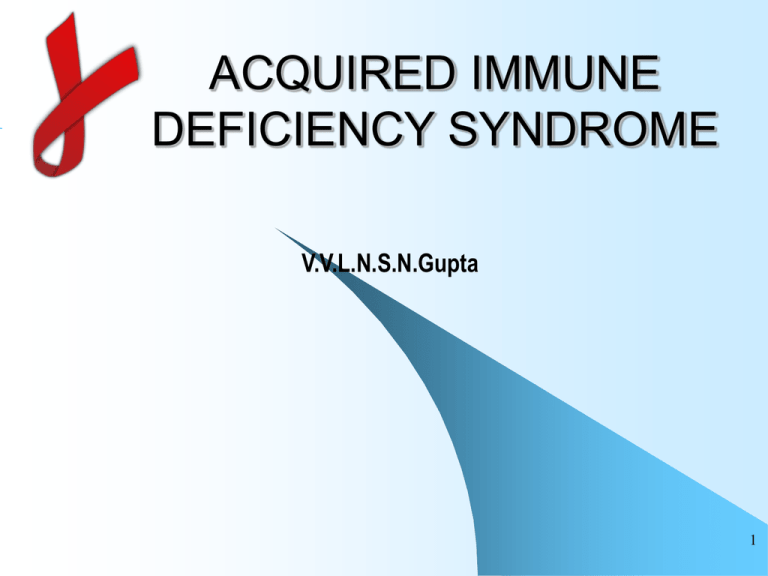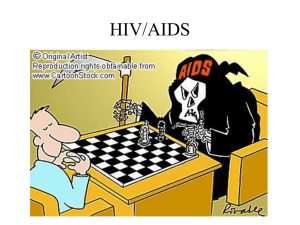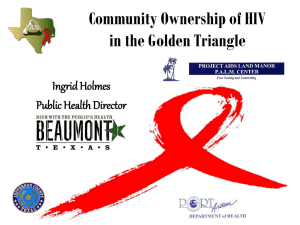
ACQUIRED IMMUNE
DEFICIENCY SYNDROME
V.V.L.N.S.N.Gupta
1
ACQUIRED IMMUNE
DEFICIENCY SYNDROME
Agent :
RETROVIRUS
Initially called Lymphadenopathy Associated Virus (LAV)
Then
Human T – cell lymphotrophic virus III
Then
Human Immuno Deficiency Virus (HIV) in 1986
2
Fatal Illness
Caused by retrovirus (Human Immuno Deficiency Virus)
Virus breaks down body’s immune system:
Victim vulnerable to
1. a)
Many life-threatening opportunistic infections
2. b)
Neurological disorders
3. c)
Unusual malignancies
Once infected, person is infected for life.
3
Recognized only in 1980s
AIDS has rapidly established itself throughout the world
In 2001 No.of adults/children
living with AIDS worldwide – 40 million
Dying with AIDS worldwide – 3 million
Male – 52%
Female – 48%
(including 7.6 million Females 15 – 49 yrs of age) living with HIV/AIDS
4
>95% Cases in developing countries
In developed nations, nos are decreasing due to combined
Antiretroviral therapy
In India ---
2nd decade
Increasing no.of Males Increasing infection in children
5
Setbacks:
·
Increased Mortality
·
Increased cost of treatment/containment
·
Decreased productivity due to morbidity
AIDS continues to roll back hard-won development gains in
many regions of the world
In South East Asian Region (SEAR), Thailand first to report a
case of AIDS
Pandemic (Global epidemic)
6
RESERVOIRS OF INFECTION:
Cases and carriers
Once a person is infected, virus remains in body life-long
Risk of developing AIDS increases with time
HIV infection takes years to manifest & so symptomless carrier
can infect other people for years.
7
SOURCE OF INFECTION:
Virus (Large concentration) + in blood, semen, CSF
Virus (lower concentration) + in tears, saliva, breast milk, Urine, Vaginal
secretions
Virus is also isolated from
Brain tissue
Lymph nodes
Bone-marrow cells
Skin
Till now only Blood & Semen have been conclusively shown to
transit the virus.
8
HOST FACTORS:
Age:
Sexually active persons 20 – 49 years
- most productive members of society
- those responsible for
O Child bearing
Child rearing
9
Sex:
Some sexual practices Increase risk of infection more than
others
Eg., Multiple sex partners, Anal intercourse, Male
homosexuality
Higher rate of HIV infection found in prostitutes
10
HIGH RISK GROUPS:
Male homosexual & Bisexuals
Heterosexual partners (including prostitutes)
IV drug abusers
Transfusion recipients of blood & blood products
Haemophiliacs
Clients of STD
11
IMMUNOLOGY:
Immune system disorders of HIV are due to gradual decrease in
specialized type of WBC (Lymphocytes) called T-helper or T-4 cells
(CD4 + T Lymphocytes)
HIV Specially infects CD4 + T Cells along with other cells
e.g., B-cells,, Microphages, Nerve cells.
When virus reproduces, infected T-helper cells are destroyed decreases
WBCs (<500.cmm)
12
IMMUNOLOGY:
Alteration in T-cell function due to infection causes
•
•
•
Development of neoplasms
Development of opportunistic infections
Inability to mount a delayed hypersensitivity response
13
MODE OF TRANSMISSION:
Sexual transmission
Blood contact
Maternal-foetal transmission (Mother child)
14
Sexual transmission:
AIDS is first and foremost a sexually transmitted disease
Any vaginal, oral or anal sex can spread AIDS
Every single act of unprotected intercourse with an HIV
infected person exposes the uninfected partner to risk of
infection
15
Size of risk is affected by :
Presence of STD
Sex and age of uninfected partner
Type of sexual act
Stage of illness of infected partner
Virulence of HIV Strain involved
Causes of transmission from Male to Female twice as much
As Female to Male because
a) Larger surface exposed in Females
b) Semen contains higher concentration of HIV than vagina or
cervical fluids
16
Anal intercourse has higher risk of transmission than Vaginal
intercourse due to increased tissue injury involved
For all forms of sex, risk increases where there is abrasion of
skin or mucus membrane
17
For vaginal sex, risk is increased during menses.
•
Exposed adolescent girls (Cervix being less efficient barrier
to HIV and less production of mucus in genital tract of
adolescent and menopausal Females ) and Females over
45 are more prone to get HIV due to thinning mucosa at
menopause
•
Presence of STD in HIV negative or HIV partner facilitates
transmission of HIV
•
If an STD e.g.., Herpes, Syphilis, Chancoid cause ulceration
in genital or perineal area of uninfected partner, HIV easily
passes into his/her tissue.
18
STD inflammation
T-cells
Monocytes
Macrophages
Get concentrated in genital area – easily catch HIV from
infected partner
19
HIV infected persons – more infectious in early stages (before
antibody production) or window period and when infection is
well advanced due to levels of virus in blood.
20
BLOOD CONTACT:
Contaminated Blood transfusion of whole blood cells, platelets,
factors VIII & IX (derived from plasma)
NOT TRANSMITTED via
Albumin
Igs
Hepatitis Vaccines that are as per WHO norms
21
Risk of HIV from contaminated blood transfusion – 95%
Needle prick – Low risk of infection
Regular needle uses by drug addicts – High risk due to
repeated use (cocaine, heroin)
Skin piercing (including injections, ear piercing, tattooing,
Acupuncture) – High risk
22
Maternal-foetal transmission:
Through placenta
During delivery
Breast-feeding
1/3rd children of HIV +ve mothers get infected by this route.
Risk is high if mother newly infected or has AIDS
Infants & children progress rapidly to AIDS
23
NOT TRANSMITTED BY:
a) Mosquitoes/insects
b) Casual social contact with infected persons including within
households or
c) By food or water or
d) To health workers in their professional contact with AIDS
patients
24
INCUBATION PERIOD:
Few months to 6 years
CLINICAL FEATURES: Four categories
I)
Initial infection with virus & development of antibodies
II)
Asymptomatic carrier state
III)
AIDS related complex
IV) AIDS
25
INITIAL INFECTION:
Mild – fever, sore throat, rash, few weeks after initial contact
Increased risk of transmission
HIV antibodies take 2-12 weeks to appear in blood stream
(Window period)
26
ASYMPTOMATIC CARRIER STATE:
Antibodies positive, but no sign of disease except
Persistent generalized lymphadenopathy.
27
AIDS RELATED COMPLEX:
Illnesses caused by damage to immune system but without
opportunistic infection & cancers associated with AIDS but have
one or more of the following:
•
Unexplained diarrhoea more than 1 month
•
Fatigue, malaise
•
Fever
•
Night sweats
•
Oral thrush
•
General lymphadenopathy
•
Spleen
28
AIDS End stage of HIV infection
•
Opportunistic infections and/or cancer occur
•
Death is due to uncontrolled/untreatable infection
•
TB/Kaposi’s Sarcoma/Candida oesophaitis
•
Cryptococcus meningitis/ pencillosis
•
Pnemocystitis carinii pneumonia/ Toxoplasma encephalitis
•
Wasting syndrome in some
•
AIDS encephalopathy or dementia
•
Persistent generalized lymphadenopathy
29
WHO case of definition for AIDS surveillance
Adult or adolescent (>12 yrs) is considered to have AIDS if a
test for HIV antibody is positive and one or more of the following
are positive.
A) >10% body weight loss/cachexia with diarrhoea or fever
or both, intermittent or constant, for at least one
month, not known to be due to condition unrelated to
AIDS
B) Cryptococcal meningitis
C) Kaposi’s sarcoma
30
D. Pulmonary/Extra Pulmonary TB
E. Neurological impairment sufficient to prevent
independent daily activities not known to be due to
condition unrelated to HIV
F. Candidiasis of esophagus
G. Clinically diagnosed life threatening or recurrent
episodes of pneumonia
H. Invasive cervical CA
31
LAB. DIAGNOSIS:
a.
A) Detection of antibody to HIV
Elisa (to detect antibody) sensitive test
Western Blot (to confirm HIV) – Confirmation test
B) Virus isolation from cultured lymphocytes
32
Non-specific findings:
Anemia
Leukopenia (especially lymphocytopenia)
Thrombocytopenia
Polyclonal Hypergammaglobulinemia
Most widely used marker -- Absolute CD4 Lymphocyte count as
it decreases, opportunistic infection risk increases
People with healthy immune system have >950
People with AIDS >200 (Prognostic)
33
CONTROL OF AIDS:
Prevention
a)
Education: Enabling people to make life-saving choices
I.
Avoiding indiscriminate sex
II.
Using condoms
III.
Avoid use shared razors & toothbrushes
IV. Avoid sharing needles & syringes in IV drug users
V.
Females suffering from AIDS or at high risk of
infection are asked to avoid getting pregnant, but
decision is patient’s
34
CONTROL OF AIDS:
VI. Educational material & guidelines for prevention should
be made widely available
VII. All mass media channels should be involved in educating
people including international travelers
35
CONTROL OF AIDS:
PREVENTION OF BLOOD BORNE HIV TRANSMISSION
•
Advise people in high risk groups to avoid donating Blood,
Body organs, sperm or other tissues
•
All blood should be screened for HIV 1 & 2 before Blood
Transfusion
•
Transmission to hemophiliacs can be decreased by
introducing heat treatment of factors VIII & IX
•
Strict sterilization practices ensured in hospitals & clinics
•
Pre- sterilized disposable syringes & needles should be
used as much as possible
•
Avoid injections unless absolutely necessary
36
CONTROL OF AIDS:
ANTIRETROVIRAL TREATMENT:
•
No vaccine or cure for HIV infection/ AIDS
•
Drugs available suppress the HIV infection rather than its
complication
•
Therapy is useful in prolonging the life of severely ill
patients but not a cure
•
These drugs suppress viral replication
•
These drugs given as combination therapy
37
CONTROL OF AIDS:
ANTIRETROVIRAL TREATMENT:
•
Post exposure prophylactic treatment started with in
hours of accidental exposure to virus
•
4 weeks of treatment with Azathioprine decreases risk
exposure by 79%
•
Combination therapy
LAMIVUDINE)
•
Advanced AIDS in source individual (AZT +
Nelfinavir)
•
With failure to resond – Stavudine + Didanosine
also
useful
(AZT
+
38
CONTROL OF AIDS:
ANTIRETROVIRAL TREATMENT:
•
Specific Prophylaxis
P.Carinii pneumonia – CD4 >200 – Cotrimoxazole
Pentamidine
Dapsone
M.avium complex – Rifabutin
39
NATIONAL AIDS PREVENTION & CONTROL POLICY
Objective: To bring about zero transmission of AIDS by 2007
Blood Safety programme
•
Only licensed blood banks allowed to operate in India
•
Voluntary Blood donation encouraged
•
Zonal blood testing centers – Test samples of blood for
blood banks & report HIV results the same day
•
Testing of every unit of blood mandatory :
40
NATIONAL AIDS PREVENTION & CONTROL POLICY
•
Testing of every unit of blood mandatory
•
HIV
•
HCV
•
Hepatitis – B
•
Malaria
•
Syphilis
41
Policy on HIV testing:
Voluntary basis with appropriate pre-test & post-test counseling
STD Control program
•
Condom promotion: social marketing of condom as a priced
item but at subsidized rate
•
Vending machine near brothels
42
HIV Surveillance:
•
Information,
Mobilization
Education,
communication
&
•
Family Health awareness campaign
•
Prevention of HIV transmission from mother to child
•
Post exposure prophylaxis for health care workers
•
National AIDS Telephone help line -- 1097
Social
43
What should one do if found HIV positive?
•
Consult a clinician experienced in treating
HIV/AIDS.
•
Protect your sex partner(s) from HIV by following
safe-sex guidelines.
•
Inform sex partner(s) who may also be infected.
•
Do not share needles.
•
Get psychological support from a counsellor
and/or join a support group for people with HIV.
•
.
44
What should one do if found HIV positive?
•
Get information and social and legal support from
AIDS service organisations.
•
Don't share your HIV status with people who do
not need to know. Only tell people you can count
on for support. Think about whom do you want to
share your HIV status with.
•
Maintain a strong immune system with a healthy
lifestyle and regular medical examinations.
•
Consider using antiretroviral therapies that may
slow the progress of the infection in consultation
with a qualified physician
45
The Risk Chart - Practice Safe Sex
No risk or very low risk - No reported cases due to these behaviors
•
Masturbation - mutual masturbation
•
Touching - massage
•
Erotic massage - body rubbing
•
Kissing
•
Oral sex on a man with a condom
•
Oral sex on a woman with a dental dam, glyde dam, plastic wrap, or
cut-open condom
•
Not sharing drug injecting, body piercing instruments, needles,
syringes
•
Using properly sterilised hospital tools
46
The Risk Chart - Practice Safe Sex
Low risk - Rare reported cases due to these behaviors
•
Deep kissing
•
Oral sex
•
Vaginal intercourse with a condom or female condom
•
Anal intercourse with a condom (Try not to get semen or
blood into the mouth or on broken skin.)
47
The Risk Chart - Practice Safe Sex
High risk - Hundreds of thousands of reported cases
are associated with the following.
•
Vaginal intercourse without a condom
•
Anal intercourse without a condom
•
Sharing needles, syringes and other body piercing
instruments
48
49
The Red ribbon is a symbol for solidarity with HIV-positive people
and those living with AIDS.
50








